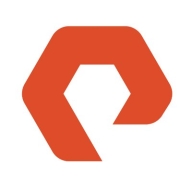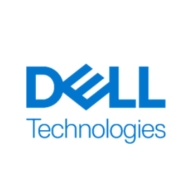


Dell PowerMax and Nutanix Unified Storage compete in the storage solutions category, focusing on providing comprehensive data management services. Dell PowerMax stands out in performance and reliability for mission-critical applications, whereas Nutanix Unified Storage shines in scalability and management simplicity, making it better for cloud integration.
Features: Dell PowerMax offers cutting-edge NVMe technology, robust SRDF replication capabilities, and exceptional data reduction, ensuring low latency and high reliability. Nutanix Unified Storage provides an integrated platform supporting block, file, and object storage, delivering significant cost savings and enhanced file analytics with Data Lens.
Room for Improvement: Dell PowerMax could further enhance end-to-end NVMe technology and simplify management processes. SRDF and CloudIQ display technical weaknesses, suggesting a need for interface and analytics upgrades. Nutanix could improve cybersecurity offerings, create more intuitive interfaces, and enhance third-party integration capabilities. Both struggle with pricing and licensing, despite Nutanix's cost-effectiveness in certain setups.
Ease of Deployment and Customer Service: Dell PowerMax is typically deployed on-premises, supported by a robust technical support team, though SLA adherence could improve. Nutanix offers broader deployment options, including hybrid cloud, and provides proactive customer service, yet users request faster support escalation.
Pricing and ROI: Dell PowerMax is perceived as expensive but justifies its cost with feature depth suitable for large enterprises, improving ROI through workload consolidation and reduced physical space. In contrast, Nutanix offers cost-effective scalability with high licensing fees for certain features, gaining rapid ROI via streamlined operations and infrastructure reduction.
By opting for the gold subscription every three years, you get a free upgrade to the latest controller release.
If you wait more than seven years to buy another one, you get a return on your investment.
During a DCDR setup and migration from VMAX to Dell PowerMax, what was planned as a two-day downtime was completed in just three to four hours.
The performance metrics or benchmarks I use to measure success with Dell PowerMax include uptime as well as our response times on our platforms, both of which are exactly where we want them to be, which is five nines and as fast as possible.
My client has seen significant ROI since the install, and when you don't go down, that's an ROI in and of itself.
For me, the biggest return on investment when using this solution is that we do not have to have much support staff to run it.
The scalability challenge with previous systems is lessened with Nutanix since we can expand by adding new hardware without needing migrations.
We are saving approximately 20% to 25% compared with the competition.
We also had one outage where a controller of one of the products had failed and had to be replaced on-site.
Customers always have their issues resolved promptly.
Pure has good storage.
I would rate Dell PowerMax support as a ten, as I have never had an issue with Dell support as it relates to this product.
Dell support for Dell PowerMax is exceptional, rating a perfect 10 out of 10.
I evaluate Dell's support for PowerMax as very good, especially regarding their response time as well as their willingness to get ahead of issues.
They come on the call, start troubleshooting immediately, and resolve issues effectively.
They are very knowledgeable, and if they can't solve the problem, they find the answer within a day or so.
I would give the customer service and technical support a ten out of ten.
It is highly scalable.
It is suitable for both medium-sized and enterprise businesses.
It hasn't broken down anytime in the last six to seven years, despite hurricanes, earthquakes, and power outages.
Scalability is not an issue.
Dell PowerMax is good for enterprises, and it also depends on how much workload you're going to bring in on Dell PowerMax in terms of performance and how many users are going to use the database you're hosting.
Volumes can be defined to grow to any level without impacting overall performance.
This means you don't have to buy everything upfront; you can buy what you need and add more as you grow, which is advantageous.
These three components utilize scalability tools, enabling storage addition to nodes and supporting independent, linear performance growth.
I can rack mount the server or node and add it to the cluster anytime with just one click.
During the eight years, there have been no problems such as hardware failure or stopping.
I would rate the stability of the solution as a ten out of ten.
I would rate the stability of the product at seven out of ten.
These patches can be applied on the fly without requiring software upgrades or system downtime.
I would rate it nine out of ten since there are no required downtimes, even during firmware upgrades.
There has been no downtime with Dell PowerMax; it's been extremely reliable, easy to manage, easy to upgrade, and trustworthy as we've upgraded over the years from one version to another.
We have not experienced these issues with Nutanix, which I attribute to the all-flash technology, the quality of their platform, and the responsiveness of the hyper-converged infrastructure.
Nutanix Unified Storage (NUS) is very stable.
It automatically triggers tasks, causing performance issues.
We would appreciate a built-in transparent failover in the next release to eliminate the need for a separate metro cluster.
I'm eagerly anticipating the roadmap's promise of introducing multiple controllers, which could significantly boost scalability and resilience.
We mostly rely on long-term releases. We don't need the most up-to-date features, but we need a reliable environment.
Compared to competitors such as NetApp, which integrates with public cloud hyperscalers (GCP, Azure, AWS), Dell PowerMax lacks in this aspect.
Dell can assist by providing plug-and-play integrated templates that allow customers to drag, drop, modify, and connect with any target system for generating snapshots without logging into the storage directly.
Dell PowerMax NVMe is very reliable storage and cannot experience downtime.
The main concern is pricing, which could deter some customers; addressing this would enhance its appeal.
The system should move towards AI-driven optimization and enhance S3 object storage capabilities.
System downtime can disturb the entire ecosystem and impact all applications.
While the prices may be higher than those of other vendors, we see it as a market leader with benefits.
The support can be a bit pricey, but the solution is more cost-effective than anything else out there.
I would give it a nine out of ten in terms of costliness.
The higher cost compared to other vendors is justified by additional features, vendor-managed upgrades, and superior support services.
It is the best choice for large projects in terms of price and features compared to midrange solutions.
The price is starting from $500,000.
Compared to buying three or four vendor solutions, it is much cheaper.
The cost has doubled for the same amount of data, which was a challenge when presenting use case justifications for the increased cost.
Nutanix Unified Storage (NUS) has definitely helped reduce our total cost of ownership.
Pure Storage has signature security technology, which cannot be deleted, even if you are an administrator.
The platform's robust features include excellent sustainability tracking, and a comprehensive dashboard offering insights into IOPS, bandwidth, performance, and virtual activities.
Its data compression feature is the best that we have ever seen.
NVMe provides additional fast cache, similar to random access memory (RAM), which improves overall system performance and read/write experience for users.
Dell PowerMax NVMe is very supportive of our operational growth since we require daily performance from our core banking systems and need to facilitate data movement efficiently.
The key benefits of using Dell PowerMax, quantified in terms of saved hours and saved costs, is having one single platform that provides functionality to all of our internal customers.
Nutanix Unified Storage (NUS) is appreciated for its fault tolerance and redundancy at the cluster level, which ensures reliable storage of files, folders, and other information accessible on the client side.
The cybersecurity features of Nutanix Unified Storage (NUS) when dealing with unstructured data, such as ransomware threats, provide the ability to detect and back up block-based storage, allowing me to restore repositories or sets of block storage with one button click, which is automatic.
My experience with using Nutanix Unified Storage (NUS) for data-intensive workloads is that we have many SQL Servers and they perform much better than they did when we used hybrid converged previously.



Pure Storage FlashArray//X is the world’s first enterprise-class, all-NVMe flash storage array. It represents a new class of storage – shared accelerated storage, which is a term coined by Gartner – that delivers major breakthroughs in performance, simplicity, and consolidation.
Dell PowerMax offers robust performance, reliability, and efficient data handling. It is recognized for its compression, deduplication, and NVMe technology, significantly benefiting data centers with its advanced replication and uptime.
PowerMax is equipped to handle mission-critical applications, providing impressive performance metrics with low latency and high IOPS capacity. Its CloudIQ and Unisphere interfaces enhance manageability, while REST API support simplifies storage management. Users in sectors like healthcare, finance, and telecommunications leverage its capabilities for database management, high-transaction block storage, and disaster recovery. However, opportunities for improving deduplication efficiency, interface complexity, and automation remain.
What are the key features of Dell PowerMax?Industries utilize Dell PowerMax to support diverse environments like VMware, Oracle, and PostgreSQL. It serves multiple sectors such as healthcare, finance, and government, aiding in data storage consolidation, disaster recovery, and high-availability hosting for critical systems and applications.
Nutanix Unified Storage provides high availability and seamless cloud platform integration, ensuring robust redundancy, scalability, and streamlined management. It supports hybrid cloud connectivity, enhancing storage security and performance.
Nutanix Unified Storage is designed for effective data protection across block, file, and object storage, offering features like ransomware detection and a centralized management interface through Prism Central. Users gain improved SLAs and IT cost savings through its efficient performance. Despite its user-friendly interface, there is a demand for enhanced security measures such as Multi-Factor Authentication and DLP. While its resilience is notable, users seek improvements in protocol compatibility, storage capabilities, pricing, and support processes.
What are the most important features of Nutanix Unified Storage?Industries implement Nutanix Unified Storage for tasks such as file storage, database performance improvement, and storage solution consolidation. Companies deploying virtual machines, securing against ransomware, connecting hybrid clouds, and backing up data find it useful. It supports workloads like Citrix VDI, Kubernetes, and research data, assisting many organizations migrating from legacy storage for better cost efficiency and reduced data center footprints.
We monitor all All-Flash Storage reviews to prevent fraudulent reviews and keep review quality high. We do not post reviews by company employees or direct competitors. We validate each review for authenticity via cross-reference with LinkedIn, and personal follow-up with the reviewer when necessary.